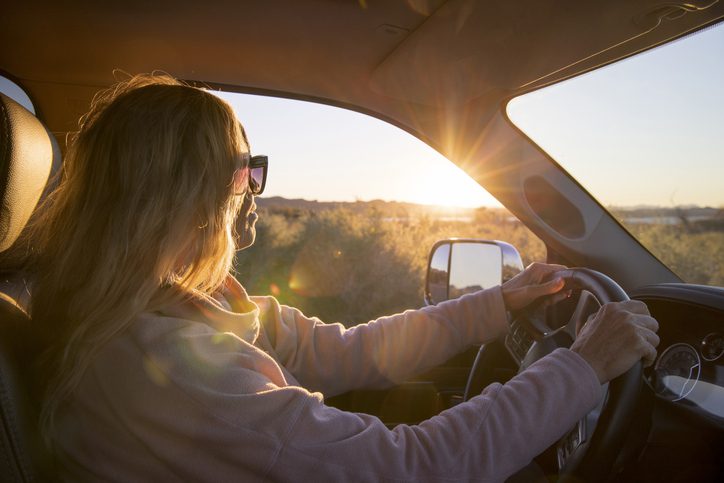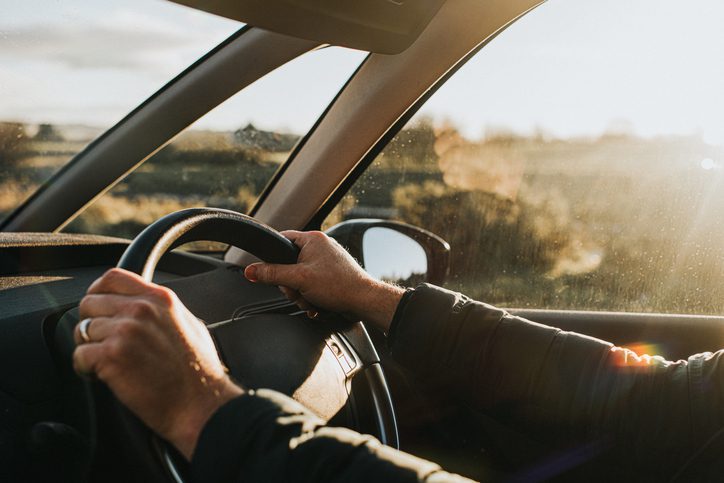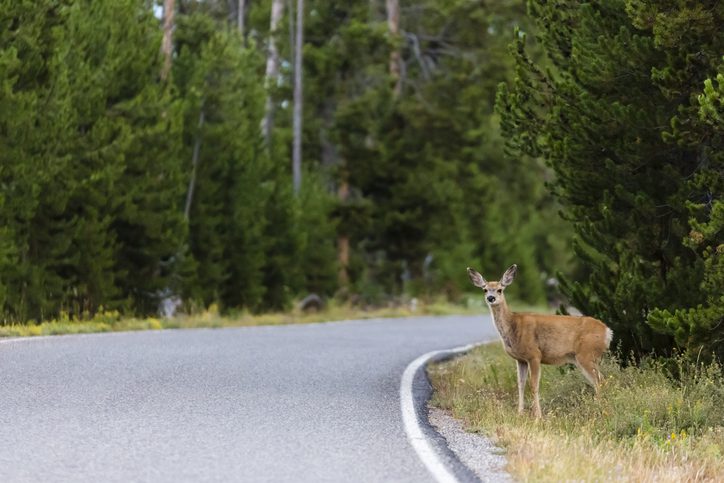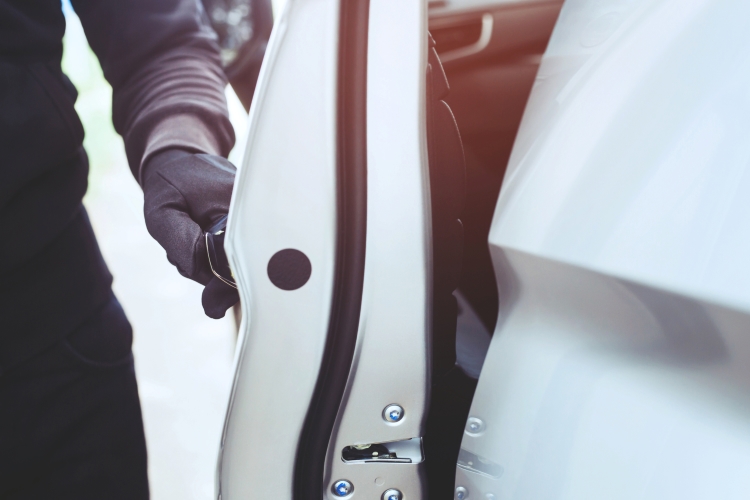Before you buckle your seat belt, pop on your sunglasses and cue up “Good Day Sunshine” on your playlist, it’s important to think about sun safety behind the wheel.
Though blue skies and sunshine may seem like perfect driving weather, hitting the road on a sunny day requires precautions just like driving in rain, ice or snow. From blinding glare to damaging UV rays, the sun poses a variety of risks to drivers and vehicles.
Learn about these hazards and pick up a few simple tips to protect yourself and your car so you can safely enjoy any sunny drive, whether it’s a quick errand or a long summer road trip.
Sun Glare: A Common Cause of Crashes
Sunshine on your shoulders may make you happy, as the song goes, but even if sunshine in your eyes doesn’t make you cry, it can impact your driving.
Over 9,000 vehicle crashes a year are related to sun glare, according to the National Highway Traffic Safety Administration. In fact, the risk of a serious crash is 16% higher in bright sunlight, according to a study on sun glare and vehicle accidents: A sunny day can cause changes in visual perception that may make drivers believe that they’re traveling more slowly, causing them to increase their speed. Sunshine also may cause glare or “dazzle,” a temporary loss of vision.
Glare isn’t just from the sun shining directly in your eyes—it can also happen when sunlight bounces off a shiny object, like the mirrors of the car in front of you.
Here are some tips to help you stay safe and prevent glare-related crashes:
- Check sunrise and sunset times. The risk of a crash from bright sunlight is highest when sunrise and sunset happen at rush hour. That’s because glare is more likely to hinder your vision when the sun is low in the sky and shining directly into your eyes. Keep tabs on sunrise and sunset times, and consider tweaking your departure time or changing your route to avoid peak glare times.
- Put on polarized sunglasses. Polarized sunglasses are designed to cut down on glare, which occurs when sunlight reflects off a smooth surface and directly into your eyes. Polarized lenses contain a special filter that can block glare, making details more crisp, creating a safer driving experience and protecting your eyes from UV rays. (Just don’t wear polarized sunglasses when driving at night or on icy roads when seeing glare could be helpful.)
- Allow more space between vehicles. Have you heard of the three-second-plus rule? The National Safety Council recommends leaving at least three seconds of space between you and the vehicle in front of you, plus an extra second for any less-than-ideal circumstances, such as rain, snow, heavy traffic, stress, illness—or a sunny day.
- Use your visors and pull over when necessary. Sun visors help drivers manage blinding sunlight, but use caution: Visors also block part of your field of vision. Just as you might exit the highway during a severe rainstorm, it may be safest to pull over and wait out intense glare for a few minutes until the angle of the sun changes in the sky.
It’s also important not to become overconfident when driving in sunny weather. No matter how beautiful the day, keep the risks of sun in mind, and use the same caution you would in rain, snow and other weather conditions.

Sun Damage to Your Skin (And Car)
Driving safety isn’t the only concern when getting behind the wheel on a sunny day. The strong UVA and UVB rays also can cause sun damage to your skin, raise your risk of skin cancer and harm your vehicle.
The sun’s UVA rays are more likely to cause tanning and premature aging, along with genetic changes that can lead to skin cancer, while UVB rays are more likely to cause sunburn, according to the Skin Cancer Foundation. Car windshields provide significant protection from these rays, but side windows and sunroofs only filter about 50% of UVA rays. There’s a higher incidence of melanoma and other skin cancers on the left side of the body, likely due to drivers being exposed to damaging rays while behind the wheel.
UV rays also can damage the interior and exterior of your vehicle. The sun degrades plastics, which is why parents and grandparents may be told to toss a towel over a child’s carseat when not in use. Over time, harsh sunlight may cause car upholstery to fade or leather to stiffen. The sun also can cause components like the dashboard, glove box or headrests to fade or crack. UV light can even damage paint on the car’s exterior, causing the clear coat to break down and lead to oxidation, cracking and peeling.
Shield Yourself (And Your Car) From UV Rays
Let’s shed some light on how to protect yourself and your vehicle from the sun’s harmful rays. Here are five steps you can take:
- Slather on sunscreen before hitting the road. Sunscreen is key to shielding your skin from UV rays while driving. The Skin Cancer Foundation recommends applying a broad-spectrum sunscreen with at least SPF 30 for short drives and SPF 50 for longer commutes or road trips. Be sure to use sunscreen year-round and on cloudy days, too.
- Cover up with protective clothing. Sunscreen alone might not offer enough protection, especially if you’re on the road for hours on an extremely sunny day. Consider donning a sun protective shirt with long sleeves or driving sleeves with built-in UV protection, as well as driving gloves to protect the delicate skin on the backs of your hands.
- Get your car windows tinted. Vehicle window tinting isn’t just for looks. It can also protect you and the interior of your car from the sun. UV window film, which contains light inhibitors, can block up to 99% of UVA and UVB rays, according to The Skin Cancer Foundation. These films come in a variety of tints, including clear, so they don’t necessarily darken your car windows. But before you get tint applied, check with your state department of motor vehicles (DMV) or local police department to find out if there are any window tinting restrictions where you live.
- Install car seat covers. Seat covers can safeguard your cloth, vinyl or leather vehicle upholstery from UV light damage. These covers can be an affordable way to protect your vehicle, and they’re easy to install. There’s a bonus too: if you have leather or faux leather seats, you can choose a material like cloth that won’t heat up, making it much more comfortable to slip into the driver’s seat on a hot day.
- Park in the shade. Finally, park carefully to protect the interior and exterior of your car, truck or SUV. Seek out a shady spot when you can, even if it means getting in some extra steps when walking from your car to the store. If you don’t have a garage or a shady spot at home, consider installing a carport to protect your ride. Also remember to keep your sun roof cover closed, and consider using a windshield sun shade for added protection for your vehicle’s interior, especially when there’s no shade to be found.







Wow! This has some good information. Thank you for this. I appreciate you sending this information to me.
Was very informative and helpful
Very helpful, thank you. Didn’t know to wear sunscreen in the winter,